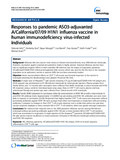Responses to pandemic AS03-adjuvanted A/California/07/09 H1N1 influenza vaccine in human immunodeficiency virus-infected individuals

View/
Date
2012-08-31Author
Kelly, Deborah
Burt, Kimberley
Missaghi, Bayan
Barrett, Lisa
Keynan, Yoav
Fowke, Keith
Grant, Michael
Type
Journal ArticleMetadata
Show full item recordAbstract
Abstract
Background
Influenza infection may be more serious in human immunodeficiency virus (HIV)-infected individuals, therefore, vaccination against seasonal and pandemic strains is highly advised. Seasonal influenza vaccines have had no significant negative effects in well controlled HIV infection, but the impact of adjuvanted pandemic A/California/07/2009 H1N1 influenza hemaglutinin (HA) vaccine, which was used for the first time in the Canadian population as an authorized vaccine in autumn 2009, has not been extensively studied.
Objective
Assess vaccine-related effects on CD4+ T cell counts and humoral responses to the vaccine in individuals attending the Newfoundland and Labrador Provincial HIV clinic.
Methods
A single dose of ArepanrixTM split vaccine including 3.75 μg A/California/07/2009 H1N1 HA antigen and ASO3 adjuvant was administered to 81 HIV-infected individuals by intramuscular injection. Plasma samples from shortly before, and 1–5 months after vaccination were collected from 80/81 individuals to assess humoral anti-H1N1 HA responses using a sensitive microbead-based array assay. Data on CD4+ T cell counts, plasma viral load, antiretroviral therapy and patient age were collected from clinical records of 81 individuals.
Results
Overall, 36/80 responded to vaccination either by seroconversion to H1N1 HA or with a clear increase in anti-H1N1 HA antibody levels. Approximately 1/3 (28/80) had pre-existing anti-H1N1 HA antibodies and were more likely to respond to vaccination (22/28). Responders had higher baseline CD4+ T cell counts and responders without pre-existing antibodies against H1N1 HA were younger than either non-responders or responders with pre-existing antibodies. Compared to changes in their CD4+ T cell counts observed over a similar time period one year later, vaccine recipients displayed a minor, transient fall in CD4+ T cell numbers, which was greater amongst responders.
Conclusions
We observed low response rates to the 2009 pandemic influenza vaccine among HIV-infected individuals without pre-existing antibodies against H1N1 HA and a minor transient fall in CD4+ T cell numbers, which was accentuated in responders. A single injection of the ArepanrixTM pandemic A/California/07/2009 H1N1 HA split vaccine may be insufficient to induce protective immunity in HIV-infected individuals without pre-existing anti-H1N1 HA responses.
URI
http://dx.doi.org/10.1186/1471-2172-13-49http://erepository.uonbi.ac.ke:8080/xmlui/handle/123456789/14680
